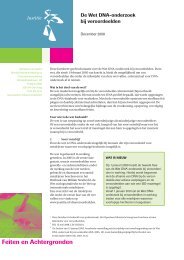INTERPOL HANDBOOK ON DNA DATA EXCHANGE AND PRACTICE
INTERPOL HANDBOOK ON DNA DATA EXCHANGE AND PRACTICE
INTERPOL HANDBOOK ON DNA DATA EXCHANGE AND PRACTICE
Create successful ePaper yourself
Turn your PDF publications into a flip-book with our unique Google optimized e-Paper software.
FAMILIAL SEARCHINGThe idea that a <strong>DNA</strong> Database could be used to identify a close relative of theperpetrator was foreseen during the initial evaluation of forensic <strong>DNA</strong> technology.In the United States, the National Research Council described this issue in their firstpublished report:“When a biological sample is found at the scene of a crime, the <strong>DNA</strong> pattern canbe determined and be made compatible with a databank. If the unidentified <strong>DNA</strong>profile perfectly matches a sample in the convicted-criminal databank at enough loci,the probable perpetrator is likely to have been found. However, a different outcomecould occur: the sample might match no entry perfectly, but match some entry atabout one allele per locus. Depending on the number of loci studied, one could have acompelling case that the source of the sample was a first-degree relative (e.g., brother)of the convicted criminal whose entry was partially matched… Such informationcould be sufficient to focus police attention on a few persons and might be enough topersuade a court to compel a blood sample that could be tested for an exact matchwith the sample. To put it succinctly, <strong>DNA</strong> databanks have the ability to point not justto individuals but to entire families - including relatives who have committed no crime.Clearly, this poses serious issues of privacy and fairness. As we point out more fullylater (see Privacy and Data Protection), it is inappropriate, for reasons of privacy, to searchdatabanks of <strong>DNA</strong> from convicted criminals in such a fashion. Such uses should beprevented both by limitations on the software for search and by statutory guaranteesof privacy 15 .”This issue had remained in the background in most countries with the exception ofthe United Kingdom and the United States. Since the United Kingdom and UnitedStates maintain two of the worlds’ largest investigative or offender <strong>DNA</strong> Databases,the debate in both of these countries is not surprising.Most countries implement <strong>DNA</strong> Database programs to store <strong>DNA</strong> profiles of specificcategories of offenders or suspects, with these categories expanding over time. Ingeneral, the initial offender databases covered violent and sex offenders. Today, mostdatabases include all felony offenders and there is a growing trend to include personsarrested for specific offences and suspects. Now that the <strong>DNA</strong> Databases have grownin size, the efforts to fully exploit the power of these investigative <strong>DNA</strong> Databases areincreasing and the issue of “familial searching” is receiving significant attention.The United Kingdom’s national <strong>DNA</strong> Database (N<strong>DNA</strong>D), operated by the ForensicScience Service (FSS), is the only database to have an active “Familial SearchingProgram.” A familial search must be approved by the Association of Chief PoliceOfficers (ACPO - an independent body that co-ordinates police services in England,Wales and Northern Ireland). Searches are considered when all investigative leads areexhausted and the search requires payment of a fee. “Familial searching” is creditedwith solving approximately two dozen cases in the UK since its introduction 16 .PAGE 74FAMILIAL SEARCHING







